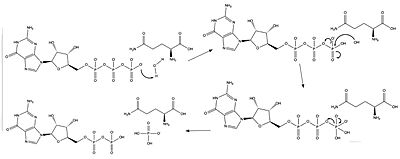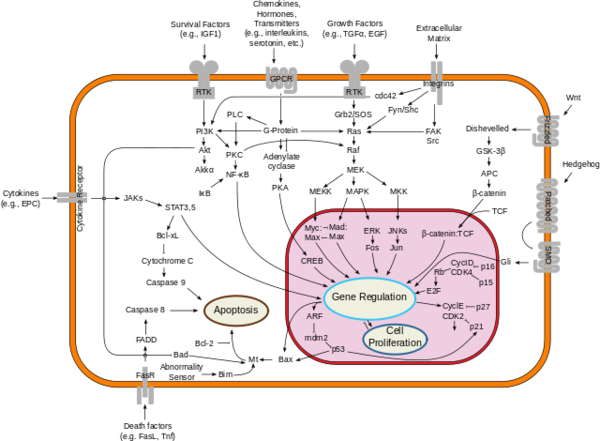Introduction
Neurofibromin is a cytoplasmic protein located close to the cell membrane that is encoded by the NF1 gene located on chromosome 17 [1]. It is a suppressor of the Ras oncogene through its effect on the rate of catalysis from (active) to Ras-GDP (inactive)[2]. NF increasing the rate of catalysis of Ras means that Ras spends more time in its inactive state and cannot cause unnecessary cell proliferation linked to cancer[3].
Structure
Conformations
Neurofibromin is a dimeric protein that is found in the cytoplasm. It exists in two conformations, and . The open conformation has one of the protomers in an auto-inhibited conformation and the other in an open conformation. In the , Ras is able to bind to the GRD neurofibromin. The has both protomers in an autoinhibited conformation, which sterically hinders the binding of Ras to GRD. Only one of the protomers has to be in the open conformation for Ras to bind.
Domains

Figure 1. Domains of Neurofibromin.
GRD domain
The Gap-related domain, or GRD, is the catalytic domain of neurofibromin. This domain also contains a tubulin-binding domain. Its main catalytic mechanism is the hydrolysis of GTP-bound Ras into GDP-bound Ras, which converts Ras from its active form into its inactive form. The GRD provides an arginine residue, known as the arginine finger, to Ras.
SEC-PH
The Sec-PH domain is the lipid-binding domain of neurofibromin. In the of neurofibromin, the hydrophobic core is blocked by the Gap-related domain. The allows the hydrophobic core in the Sec cavity to be accessible and exposed.
CSRD and CTD
The Cysteine-Serine-rich domain (CSRD) and C-terminal domain (CTD) contain phosphorylation sites. The CSRD is able to be phosphorylated by protein kinases A and C. Phosphorylation by protein kinase C is a positive regulator of neurofibromin activity. The CTD is phosphorylated primarily by protein kinase C. This domain is a negative regulator of neurofibromin activity if particular residues are phosphorylated. It also plays an important role in tubulin binding, as it helps in the transition from metaphase to anaphase. CTD contains a nuclear localization signal as well.
Important Structural Features
Active Site
Ras and Neurofibromin associate through an arginine residue, 1276, that comes from neurofibromin. This arginine is referred to as the “arginine finger” and assists in the hydrolysis of GTP by binding to a backbone carbon atom of tyrosine 32 of Ras when neurofibromin is in the open conformation. It points into the GTP binding site of Ras when neurofibromin is in the open conformation. R1276 also helps stabilize the position of Glutamine 61, a key catalytic residue, through hydrogen bonds.
Glutamine 61 of Ras is a residue that facilitates the conversion of GTP to GDP, turning Ras from its active state to inactive state. There is a catalytic water molecule that glutamine interacts with to position the molecule for a nucleophilic attack on the gamma phosphate of GTP. Mutations of this residue have been related to lower rates of hydrolysis. [4]. Tyrosine 32 makes water-mediated hydrogen bonds with the gamma phosphate of GTP. This position is also where Ras is phosphorylation to promote the activity of GTPase-activating proteins and GTP hydrolysis. [5]
RAS Complex
Mechanism of Ras Coupled with Neurofibromin
The RasGAP interactions that occur when neurofibromin's have two critical catalytic components. The first is the of the NF protein, which stabilizes the catalytic glutamine, as well as stabilizing the transition state of the phosphoryl transfer[6]. The second component is the of the Ras protein, which stabilizes the nucleophilic water as it attacks the third phosphate group in the GTP molecule as shown in Figure 1[7].

Figure 1: The catalytic glutamine stabilizes the nucleophilic water.
Downstream Effects
The NF1 gene that neurofibromin encodes has a high mutation rate, however it is difficult to detect the mutations because of how large the protein is and how randomly the mutations are distributed across the protein. Many of the mutations have been detected in the catalytic Gap-related domain. Misregulated Ras activity can lead to uncontrolled signaling in many different cell signaling pathways. Figure 2 provides an overview of the pathways that are connected to Ras, such as the MEK pathway. Eventually, the pathways relate to gene regulation and cell proliferation. If Ras is hyperactive, cell overgrowth and cancer can result. A focus of drug design is the suppression of Ras and its downstream signaling pathways.
Disease Relevance
Mutations to the neurofibromin protein are implicated in the progression of Neurofibromatosis type 1 (NF1). This condition drives several forms of human cancers by inactivating the Ras suppression effects of NF, allowing Ras to behave as an oncogene. Neurofibromatosis type 1 is an autosomal dominant disorder that affects 1 in 3,000 people, and the NF gene itself has the highest mutation rate of any known human gene, adding to its prevalence[8]. NF1 primarily causes tumors in the central and peripheral nervous systems, but often has a multisystem expression including tumors in the dermatologic, cardiovascular, gastrointestinal, and orthopedic systems[9]. The wide range of presentations is consistent with the multiplicity of mutations observed in the causative protein[10].



